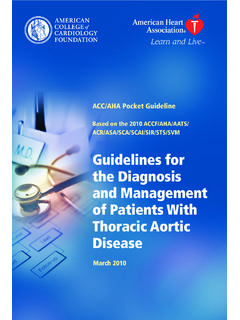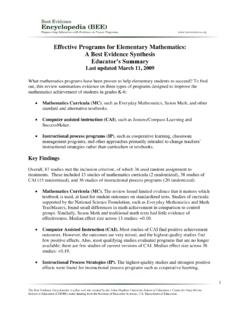Transcription of Based on the 2011 ASA/ACCF/AHA/AANN/AANS/ACR/ …
1 ACCF/AHA Pocket Guideline Based on the 2011. ASA/ACCF/AHA/AANN/AANS/ACR/. CNS/SAIP/SCAI/SIR/SNIS/SVM/SVS. Guideline on the management of patients with extracranial Carotid and Vertebral Artery Disease Developed in Collaboration with the American Academy of Neurology and Society of Cardiovascular Computed Tomography January 2011. Guideline on the management of patients with extracranial Carotid and Vertebral Artery Disease January 2011. ACCF/AHA Writing Committee Thomas G. Brott, MD, Co-Chair Jonathan L. Halperin, MD, Co-Chair Suhny Abbara, MD. J. Michael Bacharach, MD. John D. Barr, MD. Ruth L. Bush, MD, MPH.
2 Christopher U. Cates, MD. Mark A. Creager, MD. Wesley S. Moore, MD. Peter D. Panagos, MD. Thomas S. Riles, MD. Robert H. Rosenwasser, MD. i 2011 by the American College of Cardiology Foundation and the American Heart Association, Inc. The following material was adapted from the 2011 ASA/ ACCF/AHA/AANN/AANS/. ACR/CNS/SAIP/SCAI/SIR/ SNIS/SVM/SVS Guideline on the management of patients with extracranial Carotid and Vertebral Artery Disease. (Executive Summary: Circulation. 2011;124:489 532; Full-Text: Circulation. 2011;124:e54 e130; Executive Summary: Stroke. 2011;42:e420 e463; Full-Text: Stroke. 2011;42:e464 e540).
3 This pocket guideline is available on the World Wide Web sites of the American College of Cardiology (www. ) and the American Heart Association ( ). For copies of this document, please contact Elsevier Inc. Reprint Department, e-mail: phone: 212-633-3813; fax: 212-633-3820. Permissions: Multiple copies, modification, alteration, enhancement, and/or distribution of this document are not permitted without the express permission of the American College of Cardiology Foundation. Please contact Elsevier's permission department at Contents 1. 3. 2. Duplex Ultrasonography to Evaluate Asymptomatic patients with Known or Suspected Carotid Stenosis.
4 4. 3. Diagnostic Testing in patients with Symptoms or Signs of ECVD .. 5. 4. Treatment of Hypertension .. 6. 5. Cessation of Tobacco Smoking .. 6. 6. Control of Hyperlipidemia .. 6. 7. management of Diabetes Mellitus in patients with Atherosclerosis of the extracranial Carotid or Vertebral Arteries .. 6. 8. Antithrombotic Therapy in patients with extracranial Carotid Atherosclerotic Disease Not Undergoing 7. 9. Selection of patients for Carotid 8. 10. Periprocedural management of patients Undergoing 9. 11. management of patients Undergoing 10. 2. 12. management of patients Experiencing Restenosis After CEA or CAS.
5 10. 13. Vascular Imaging in patients with Vertebral Artery Disease .. 11. 14. management of Atherosclerotic Risk Factors in patients with Vertebral Artery Disease .. 11. 15. management of patients with Occlusive Disease of the Subclavian and Brachiocephalic 12. 16. Carotid Artery Evaluation and Revascularization Before Cardiac 13. 17. management of patients with FMD of the extracranial Carotid Arteries .. 13. 18. management of patients with Cervical Artery Dissection .. 13. 3. 1. Introduction extracranial carotid and vertebral artery disease (ECVD) encompasses several disorders that affect the arteries that supply the brain and is an important cause of stroke and transient cerebral ischemic attack.
6 The most frequent cause is atherosclerosis, but other causes include fibromuscular dysplasia (FMD), cystic medial necrosis, arteritis, and dissection. Atherosclerosis is a systemic disease, and patients with ECVD typically face an escalated risk of other adverse cardiovascular events, including myocardial infarction, peripheral arterial disease and death. To improve survival, neurological and functional outcomes and quality of life, preventive and therapeutic strategies must address both cerebral and systemic risk. 4. 5. Table 1. Applying Classification of Recommendations and Level of Evidence S I Z E OF.
7 CLASS I CLASS IIa Benefit >>> Risk Benefit >> Risk Procedure/Treatment Additional studies with SHOULD be performed/ focused objectives needed administered IT IS REASONABLE to per- form procedure/administer treatment LEVEL A Recommendation that Recommendation in favor procedure or treatment of treatment or procedure Multiple populations is useful/effective being useful/effective evaluated*. Sufficient evidence from Some conflicting evidence Data derived from multiple multiple randomized trials from multiple randomized randomized clinical trials or meta-analyses trials or meta-analyses or meta-analyses LEVEL B Recommendation that Recommendation in favor procedure or treatment of treatment or procedure Limited populations is useful/effective being useful/effective evaluated*.
8 Evidence from single Some conflicting Data derived from a randomized trial or evidence from single single randomized trial nonrandomized studies randomized trial or or nonrandomized studies nonrandomized studies LEVEL C Recommendation that Recommendation in favor Very limited populations procedure or treatment is of treatment or procedure useful/effective being useful/effective evaluated*. Only expert opinion, case Only diverging expert Only consensus opinion studies, or standard of care opinion, case studies, of experts, case studies, or standard of care or standard of care Suggested phrases for should is reasonable writing recommendations is recommended can be useful/effective/beneficial is indicated is probably recommended is useful/effective/beneficial or indicated Comparative treatment/strategy A is treatment/strategy A is probably effectiveness phrases recommended/indicated in recommended/indicated in preference to treatment B preference to treatment B.
9 Treatment A should be chosen it is reasonable to choose over treatment B treatment A over treatment B. 6. TREATM E N T EF F E C T. * Data available from clinical trials or registries about the CLASS IIb CLASS III No Benefit usefulness/efficacy in different subpopulations, such Benefit > Risk or CLASS III Harm as sex, age, history of diabetes, history of prior Additional studies with broad Procedure/ myocardial infarction, history of heart failure, and prior Test Treatment objectives needed; additional aspirin use. A recommendation with Level of Evidence COR III: Not No Proven registry data would be helpful B or C does not imply that the recommendation is No benefit Helpful Benefit weak.
10 Many important clinical questions addressed in Procedure/Treatment COR III: Excess Cost Harmful Harm w/o Benefit to patients the guidelines do not lend themselves to clinical trials. MAY BE CONSIDERED. or Harmful Although randomized trials are unavailable, there may be a very clear clinical consensus that a particular test Recommendation's Recommendation that usefulness/efficacy less or therapy is useful or effective. procedure or treatment is well established not useful/effective and may For comparative effectiveness recommendations Greater conflicting be harmful (Class I and IIa; Level of Evidence A and B only), evidence from multiple Sufficient evidence from studies that support the use of comparator verbs randomized trials or multiple randomized trials or should involve direct comparisons of the treatments or meta-analyses meta-analyses strategies being evaluated.






